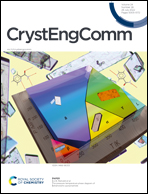Construction of two novel non-penetrating Co-MOFs derived from designed 2,4,6-tri(2,4-dicarboxyphenyl)pyridine: synthesis, structure and gas adsorption properties†
Abstract
The strategy of extending ligands and reducing symmetry provides facile access to obtain a wide variety of linkers for the construction of MOFs bearing diverse structures and intriguing properties. In this work, we employed this strategy to design and prepare a 2,4,6-tri(2,4-dicarboxyphenyl)pyridine ligand and used it to successfully construct two cobalt-based MOFs with the formula [(NH2Me2)2][Co2(tdp)]·2DMA·2H2O (Co-MOF 1) and [(NH2Me2)2][Co7(μ3-OH)4(tdp)2(H2O)6]·2DMA·3H2O (Co-MOF 2) (H6tdp = 2,4,6-tri(2,4-dicarboxyphenyl)pyridine), which were thoroughly characterized by various techniques including FTIR, TGA, PXRD and single-crystal X-ray diffraction. Both MOFs have non-penetrating network structures. Co-MOF 1 shows a three-dimensional honeycomb structure through sharing Co2+. Co-MOF 2 has a nanotube structure formed by bridging a Co7O cluster with a tdp6− ligand. Furthermore, the gas adsorption properties with respect to C2H2, C2H4, CO2, and CH4 were systematically investigated. By comprehensive comparison, Co-MOF 1 is a highly promising material for C2H2/CH4, C2H4/CH4 and CO2/CH4 separations. Specifically, the IAST adsorption selectivity at 298 K and 1 atm reaches 25.43, 12.47 and 11.33 for the equimolar C2H2/CH4, C2H4/CH4 and CO2/CH4 gas mixtures, respectively. More significantly, as revealed by PXRD, N2 adsorption measurements and cycle tests, Co-MOF 1 exhibits excellent chemical stability, which lays a good foundation for its practical application.



 Please wait while we load your content...
Please wait while we load your content...